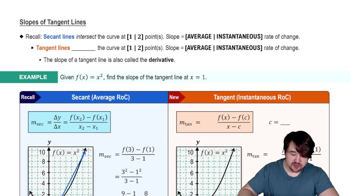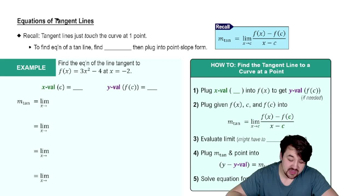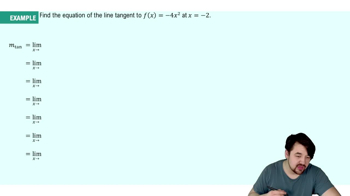Table of contents
- 0. Functions7h 52m
- Introduction to Functions16m
- Piecewise Functions10m
- Properties of Functions9m
- Common Functions1h 8m
- Transformations5m
- Combining Functions27m
- Exponent rules32m
- Exponential Functions28m
- Logarithmic Functions24m
- Properties of Logarithms34m
- Exponential & Logarithmic Equations35m
- Introduction to Trigonometric Functions38m
- Graphs of Trigonometric Functions44m
- Trigonometric Identities47m
- Inverse Trigonometric Functions48m
- 1. Limits and Continuity2h 2m
- 2. Intro to Derivatives1h 33m
- 3. Techniques of Differentiation3h 18m
- 4. Applications of Derivatives2h 38m
- 5. Graphical Applications of Derivatives6h 2m
- 6. Derivatives of Inverse, Exponential, & Logarithmic Functions2h 37m
- 7. Antiderivatives & Indefinite Integrals1h 26m
2. Intro to Derivatives
Tangent Lines and Derivatives
Problem 38b
Textbook Question
Find an equation of the line tangent to the graph of f at (a, f(a)) for the given value of a.
f(x) = √x+2; a=7
 Verified step by step guidance
Verified step by step guidance1
Step 1: Understand that the equation of a tangent line to the graph of a function at a point (a, f(a)) is given by the formula y - f(a) = f'(a)(x - a), where f'(a) is the derivative of the function evaluated at x = a.
Step 2: Find the derivative of the function f(x) = \sqrt{x+2}. Use the chain rule: if f(x) = (x+2)^{1/2}, then f'(x) = \frac{1}{2}(x+2)^{-1/2} \cdot 1.
Step 3: Simplify the derivative: f'(x) = \frac{1}{2\sqrt{x+2}}.
Step 4: Evaluate the derivative at x = a = 7: f'(7) = \frac{1}{2\sqrt{7+2}} = \frac{1}{2\sqrt{9}} = \frac{1}{6}.
Step 5: Use the point-slope form of the tangent line equation with f(7) = \sqrt{7+2} = 3 and f'(7) = \frac{1}{6} to write the equation: y - 3 = \frac{1}{6}(x - 7).
Recommended similar problem, with video answer:
 Verified Solution
Verified SolutionThis video solution was recommended by our tutors as helpful for the problem above
Video duration:
7mPlay a video:
Was this helpful?

 5:13m
5:13mWatch next
Master Slopes of Tangent Lines with a bite sized video explanation from Nick
Start learningRelated Videos
Related Practice




